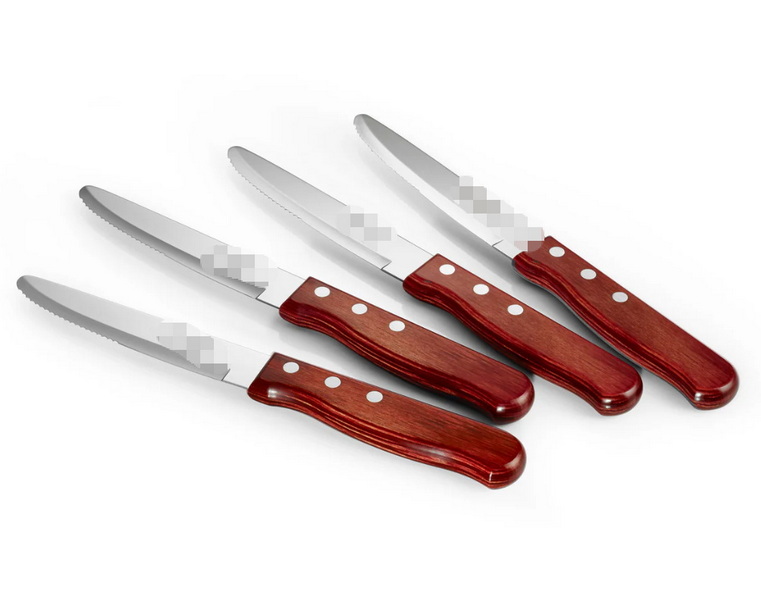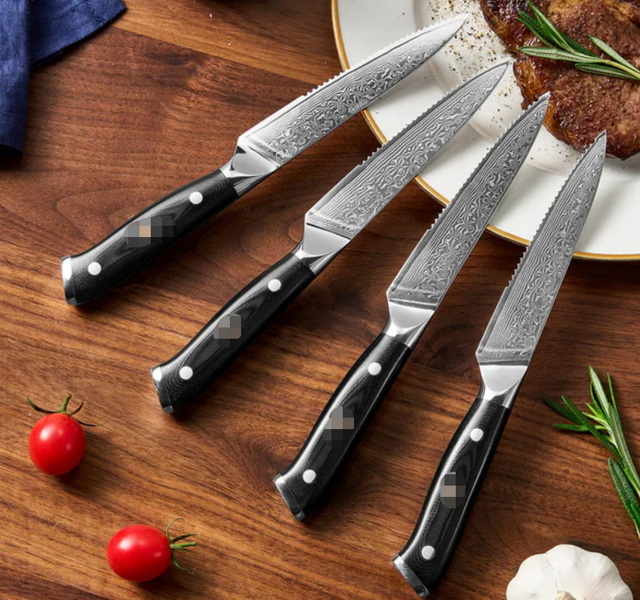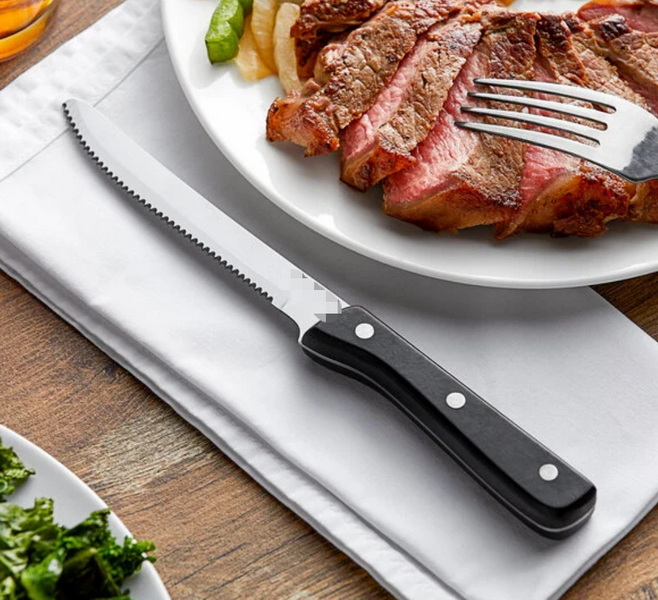- All
- Product Name
- Product Keyword
- Product Model
- Product Summary
- Product Description
- Multi Field Search
Views: 222 Author: Ann Publish Time: 2025-10-29 Origin: Site











Content Menu
● Blade materials and geometry
● Handle design considerations
● Ergonomics and user experience
● Care, maintenance, and longevity
● OEM considerations for international markets
● Care and maintenance—retained quality during service life
● Product positioning for your OEM portfolio
● Future-proofing your OEM strategy
● FAQ
>> Q1: What blade material is best for steak knives?
>> Q2: How should steak knives be sharpened and stored?
>> Q3: Are stainless steel steak knives dishwasher safe?
>> Q4: How do you choose the right steak knife for a restaurant?
>> Q5: What customization options are available in OEM programs for steak knives?
A well-chosen set of steak knives can elevate every dining experience, turning the simple act of slicing into an enjoyable, precise, and satisfying ritual. For professional kitchens, hospitality brands, and home cooks who value quality, investing in steak knives is more than a purchase; it's a commitment to consistent performance, safer handling, and enhanced presentation. This article explores why steak knife sets matter, what to look for when selecting them, how to care for them, and how to position this product in a global OEM portfolio targeted at foreign brands, wholesalers, and manufacturers. It also provides practical guidance on sourcing, customization, and marketing strategies tailored to OEM collaborations with Chinese knife manufacturers.

High-carbon stainless steel remains the workhorse for professional steak knives. It provides a strong hardness balance, edge retention, and corrosion resistance that stands up to daily use in restaurant service and home dining alike. Within this category, different grade options offer trade-offs between cost and performance.
Blade materials to consider:
- 8Cr15MoV and 420/440 stainless steels offer good value with reasonable edge life and ease of maintenance.
- 57–60 HRC range steels provide robust edge retention for heavy use while remaining relatively easy to sharpen.
- Damascus and layered steels deliver distinctive aesthetics and a premium tactile feel, appealing to brand-conscious customers.
Blade geometry and grind:
- A long, slightly curved edge facilitates clean slicing of ribeye, porterhouse, and sirloin without tearing meat fibers.
- A distal taper reduces overall blade mass toward the tip for improved control.
- A full-tang construction and a comfortable distal curvature improve balance and safety during long service shifts.
Handle materials and shapes play a critical role in comfort, hygiene, and brand differentiation. For OEM programs, offering a mix of materials can satisfy diverse regional preferences and price points.
Material options:
- Pakkawood, pakkawood composites, and high-quality resin handles for premium lines.
- Stainless steel handles for bold, durable aesthetics and easy cleaning.
- Polypropylene and POM options for mid-range offerings with reliable grip and cost efficiency.
Ergonomics:
- Balanced weight distribution between blade and handle reduces wrist fatigue during extended use.
- Contoured grips with subtle texturing improve grip confidence, especially when hands are wet or oily.
Hygiene and maintenance:
- Non-porous, dishwasher-safe handles simplify cleaning in commercial settings.
- Smooth transitions between blade and handle help prevent food residue build-up.
An ergonomic steak knife design reduces fatigue and supports precise cutting. The right balance, weight, and grip texture can transform everyday cutting into a confident, controlled action.
Weight and balance:
- A knife that feels near-balance in the hand minimizes muscle strain and enhances control during long service periods.
Grip texture:
- Subtle texturing in the handle surface provides reliable grip without causing hotspots.
Taper and flex:
- Controlled flex in certain models helps reduce resistance when slicing through thick cuts while maintaining stability for clean slices.
Proper care extends the life of steak knives and preserves their appearance, performance, and value for OEM clients.
Cleaning:
- Hand-washing is often preferred to protect edge life and handle finishes, though many premium knives tolerate gentle dishwashing.
- Prompt drying prevents water spots and corrosion on blades and fittings.
Sharpening cadence:
- Regular honing maintains edge alignment, with periodic professional sharpening recommended for optimal performance.
Storage:
- Safe, dedicated storage protects blades from nicks and dulling; consider knife blocks, magnetic strips, or protective sheaths.
Maintenance tips:
- Avoid prolonged soaking, especially for wooden handles.
- Apply food-safe mineral oil to wood handles as needed to maintain finish and prevent cracking.
When marketing steak knives to foreign brands and wholesalers, robust OEM capabilities and clear value propositions are essential.
Custom branding:
- Private label options, laser engraving, and packaging customization to align with target brands.
Packaging and presentation:
- Knife blocks, magnetic storage, and drawer organizers designed for international retailers and compliant with local packaging standards.
Compliance and safety:
- Adherence to regulatory requirements, labeling standards, and certifications in target regions (for example, safety and material compliance).
Lead times and production flexibility:
- Transparent manufacturing schedules and scalable production to meet wholesale demand.
Quality control:
- Rigorous testing for edge retention, corrosion resistance, and safety across large batches.
Packaging innovations:
- Gift-ready packaging with protective inserts to reduce transit damage and enhance unboxing experience.

Home kitchen:
- A balanced steak knife set pairs with a chef's knife, enabling efficient preparation, portioning, and plating.
Restaurant service:
- High-volume, dependable steak knives with consistent edge life streamline service and ensure uniform dining experiences.
Private label brands:
- OEM programs allow brands to tailor blade finishes, handle materials, and packaging to stand out in the market.
- Cleaning and storage routines aligned with local restaurant practices help preserve blade integrity.
- Regular honing aligns with typical turnover cycles in commercial kitchens.
- Proper storage solutions minimize accidental damage and extend blade life between service periods.
- Premium tier: Damascus or layered steel blades with exotic handle materials; luxury presentation with high-end packaging.
- Mid-range tier: High-carbon stainless steel blades with ergonomic handles; reliable performance for restaurants and households.
- Value tier: Economical stainless options with solid edge life and practical designs to meet wholesale demand.
- Accessories: Complementary knife blocks, magnetic storage solutions, and care kits to complete the offering.
Sustainability:
- Emphasize steel sourcing transparency and eco-friendly packaging options to appeal to brands with sustainability commitments.
Digital content:
- Develop a content library for product pages, brochures, and training materials featuring high-quality imagery and demonstration videos.
After-sales support:
- Provide comprehensive care guides and spare parts availability to support long-term brand relationships.
A well-crafted steak knife set is a cornerstone of a superior dining experience. For OEM partners, the opportunity lies in offering blades with excellent edge retention, ergonomic balance, and durable finishes, all backed by flexible customization options and media-rich marketing content. By focusing on blade materials, edge geometry, handle ergonomics, and robust packaging and branding solutions, Chinese knife manufacturers can deliver compelling, global-grade steak knife solutions to foreign brands, wholesalers, and manufacturers seeking reliable, aesthetically appealing products that perform consistently across diverse markets.

A1: High-carbon stainless steel offers the best combination of hardness, edge retention, and corrosion resistance, making it suitable for both professional kitchens and home use.
A2: Regular honing helps maintain edge alignment, with periodic professional sharpening for optimal performance. Store knives in a knife block, magnetic strip, or protective sheath to prevent nicks and moisture exposure.
A3: Some stainless steel knives are dishwasher safe, but repeated high-temperature cycles can degrade coatings and handle finishes. Hand washing and thorough drying extend life and preserve appearance.
A4: Prioritize edge retention, balance and ergonomics, handle durability, and ease of cleaning. Also consider bulk ordering lead times and ensuring a consistent appearance across the set.
A5: Private labeling, laser engraving, packaging customization, and options for handle materials and surface finishes to meet diverse brand positioning.
The Ultimate Professional Knives for Halal Butchery in Middle Eastern Kitchens
Chef Knife Size Guide: Choosing Between 6″, 8″, 10″, And 12″
Custom Knife Handles: How To Design A Chef Knife That Fits Your Hand Perfectly
Chef Knife Surface Treatments Guide: From Polished Migaki To Damascus Patterns
Inside Our Professional Knife Sample Room: Quality You Can See
Universal Knife Block Buying Guide: Modern Acrylic & ABS Knife Holders for Professional Kitchens
Universal Knife Block: The Complete Guide To Modern, Hygienic Knife Storage
The Complete Guide To Red Handle Knife Sets: Style Meets Functionality in The Kitchen
Professional Knives for Halal Butchery And Middle Eastern Cuisine